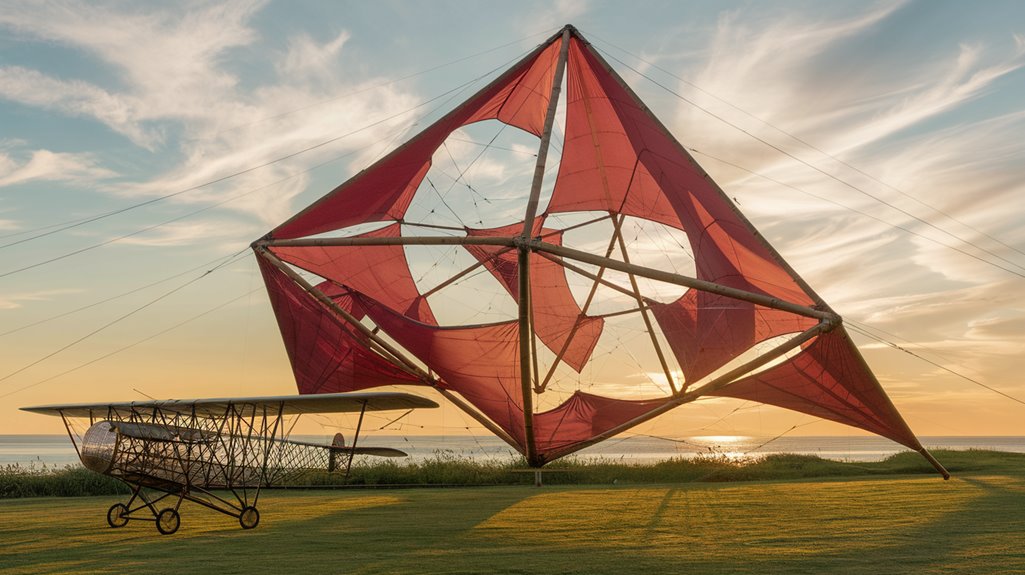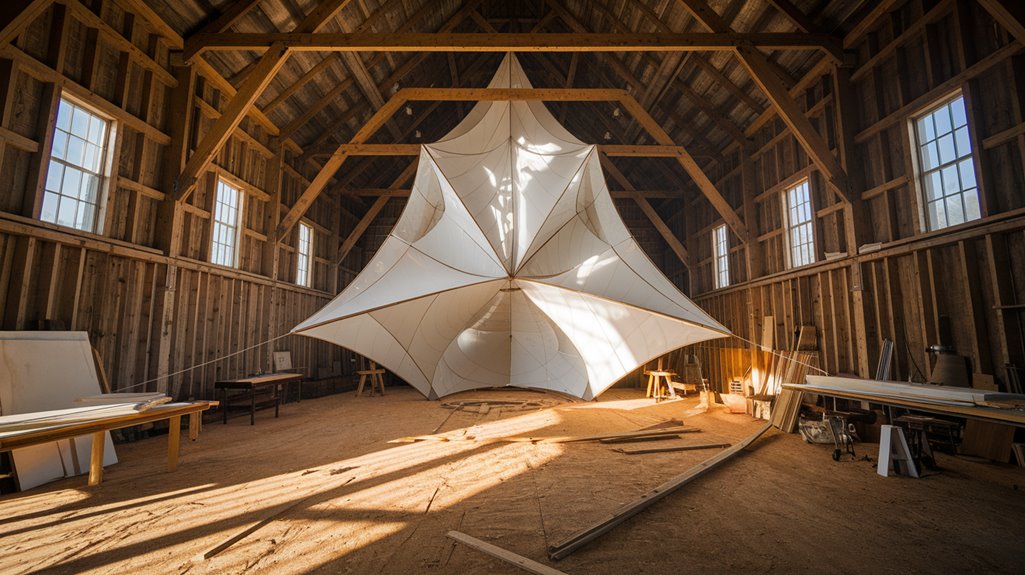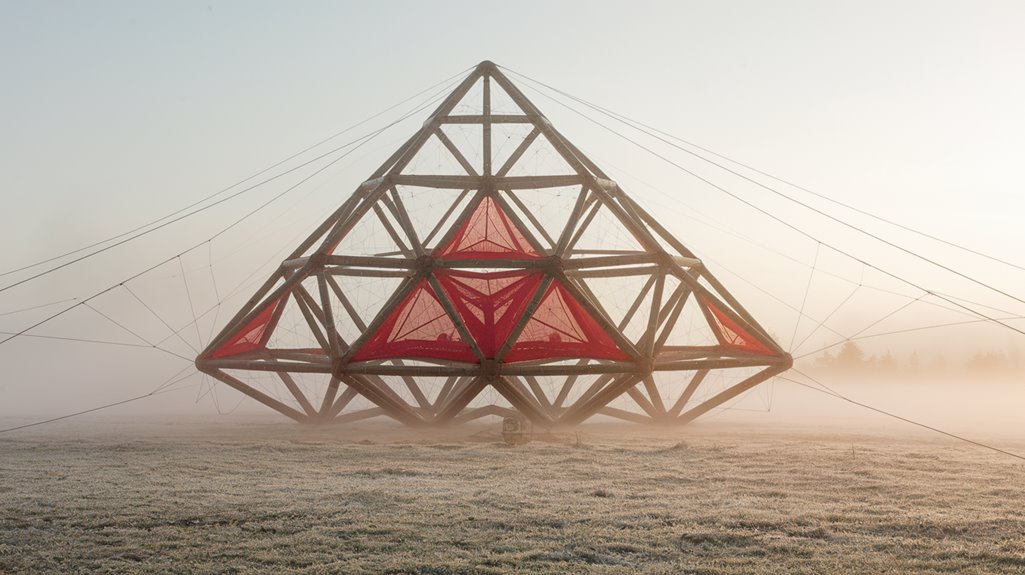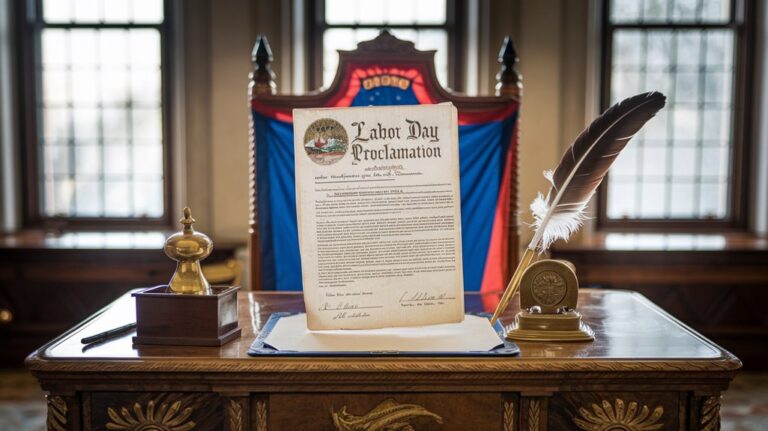Alexander Graham Bell’S Secret Obsession With Giant Kites
You might know Alexander Graham Bell as the inventor of the telephone, but there's a fascinating story about his lesser-known passion. While the world celebrated his communication breakthrough, Bell quietly devoted decades to experimenting with massive tetrahedral kites. These weren't your typical backyard flyers – some spanned over 40 feet across. His obsession with these geometric giants would ultimately reshape our understanding of flight and contribute to aviation's early development in ways you'd never expect.
The Unexpected Journey From Telephones to Tetrahedral Kites

Drawing inspiration from Lawrence Hargrave's box kites designs, Bell's aeronautical innovation took shape in the form of tetrahedral kites.
These weren't your ordinary flying toys – they were sophisticated structures built from interlocking wooden or metal rods forming pyramid-like shapes.
Bell's vision was clear: he wanted to create a design that could carry both a person and a motor.
His revolutionary approach used the tetrahedral principle to guarantee strength and stability, setting the foundation for modern aircraft design. While developing these kites, he worked from his laboratory in Baddeck, where he conducted extensive testing.
His most ambitious project, the Cygnet, incorporated an astounding 3,393 tetrahedral cells in its construction, though it ultimately failed to achieve sustained flight.
Building the Sky-High Dream: Bell's Revolutionary Design
When Bell set out to revolutionize kite design, he focused on creating a structure that could withstand both weight and wind. His solution? The tetrahedral kite, built from individual cells using 10-inch spruce rods and red silk.
You'll find his kite construction techniques were remarkably innovative – each cell weighed just an ounce but provided exceptional stability. Bell and his Aerial Experiment Association collaborated extensively on these designs. The kites achieved great success in moderate to strong winds.
The modular design advantages became clear as Bell expanded his creations. By connecting cells with metal fittings, you could build increasingly larger structures without sacrificing strength.
This scalability reached its peak with the Cygnet, an impressive construction of 3,393 cells. The local community of Baddeck, Nova Scotia, played a vital role in bringing these massive kites to life, with townspeople helping to assemble the intricate structures that would eventually take to the skies.
The Cygnet Takes Flight: A Historic Achievement
After years of meticulous development, Bell's ambitious Cygnet project culminated in a groundbreaking flight on December 6, 1907.
At Baddeck, Nova Scotia, you would've witnessed this massive 91-kg tetrahedral kite being towed behind a steamship, showcasing Bell's remarkable flight innovation. The Cygnet, with its 3,393 cells made of deep red silk, soared to an impressive height of 50 meters with Lieutenant Selfridge aboard.
For seven minutes, Bell's kite technology proved its worth as the structure maintained stability in the air. One hundred years later, in 2007, kite flying enthusiasts gathered to commemorate this historic achievement at the same location.
Through his work with the Aerial Experiment Association, Bell collaborated with talented innovators like Glenn Curtiss to advance early aviation technology.
Though the flight ended in disaster when the kite was dragged through water, this historic achievement validated Bell's tetrahedral design principles.
The experiment's success influenced future developments in hang glider design and construction space frames, despite Bell later abandoning his kite experiments in 1912.
Wind, Water, and Horsepower: Bell's Testing Grounds
Throughout his pursuit of aviation breakthroughs, Alexander Graham Bell established sophisticated testing facilities in Baddeck, Nova Scotia, where he'd conduct experiments across multiple domains.
His kite innovations focused on tetrahedral designs with diagonal cross bracing, making them stronger and more stable in windy conditions. One of his massive experimental kites contained 3,393 tetrahedral cells, demonstrating the scalability of his innovative approach.
You'd be fascinated to learn that Bell didn't limit himself to air experiments. In 1908, he began hydrofoil experiments after reading about Enrico Forlanini's work in Scientific American.
He developed the HD-1 hydrodrome, which successfully lifted boats above water to reduce friction. Working alongside pioneers like Glenn Curtiss through the Aerial Experiment Association, Bell integrated motors and propellers into his designs. His groundbreaking HD-4 achieved a record 71 mph in 1919, maintaining this speed milestone for an entire decade.
His testing grounds became a hub of innovation, where he'd blend wind, water, and horsepower in his relentless quest for flight.
Beyond Flight: The Scientific Legacy of Bell's Kite Experiments

Bell's scientific legacy extends far beyond his tetrahedral kite experiments at Baddeck.
You'll find his influence in modern hang gliders, which still incorporate his pioneering diagonal cross-bracing techniques and geometric principles. His meticulous experimental methodologies and documentation have provided invaluable insights into early kite aerodynamics, shaping how we perceive flight dynamics today. His extensive research using maroon silk material demonstrated remarkable innovation in lightweight construction techniques.
Through his work with the Aerial Experiment Association and collaborations with aviation pioneers like Glenn Curtiss, Bell's research has become a cornerstone of aeronautical education. The Cygnet's successful seven-minute test flight demonstrated the potential of his innovative designs, despite its eventual crash.
You can see his impact in modern classrooms, where teachers use tetrahedral kite principles to demonstrate complex geometric concepts. His preserved papers and experimental records continue to inspire new generations of engineers and scientists, proving that his obsession with kites helped lay the groundwork for modern aviation science.
From Giant Kites to Modern Aviation: Bell's Lasting Impact
While many know Alexander Graham Bell for inventing the telephone, his groundbreaking work in aviation has left an equally profound mark on modern flight. His innovative kite technology, particularly the tetrahedral design, revolutionized how we approach aircraft stability and strength. His extensive testing of different kites and currents helped lay crucial groundwork for understanding aerodynamics.
The AEA team under his leadership developed four powered airplanes in Hammondsport, New York.
You'll find his influence in every modern airplane through features he pioneered, including ailerons and enclosed cockpits.
Through his Aerial Experiment Association, Bell's vision drove aviation evolution forward. His team achieved Canada's first powered flight with the Silver Dart and broke multiple records along the way.











